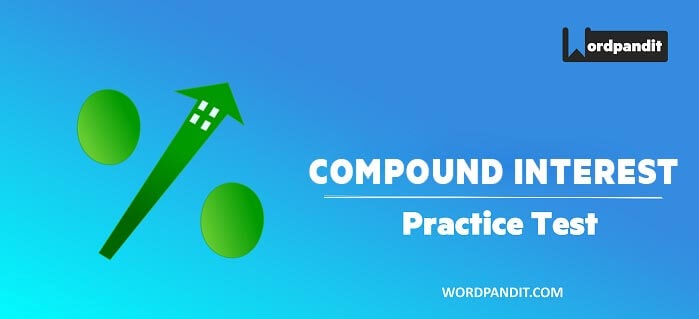- This is an assessment test.
- To draw maximum benefit, study the concepts for the topic concerned.
- Kindly take the tests in this series with a pre-defined schedule.
Arithmetic: Compound Interest Test -1
Congratulations - you have completed Arithmetic: Compound Interest Test -1.You scored %%SCORE%% out of %%TOTAL%%.You correct answer percentage: %%PERCENTAGE%% .Your performance has been rated as %%RATING%%
Your answers are highlighted below.
Question 1 |
Ravi Shankar takes money from the employees’ cooperative society at lower rate of interest and saves in a scheme, which gives him a compound interest of 20%, compounded annually. Find the least number of complete years after which his sum will be more than double.
4 yr | |
2 yr | |
6 yr | |
8 yr |
Question 1 Explanation:
Let us assume the sum of money be S
Since the sum is compounded annually so it becomes
S (1+20/100)t ≥ 2S
=> (6/5)t ≥ 2
=> (1.2)t ≥ 2
Hence the least number of complete years are 4
Since the sum is compounded annually so it becomes
S (1+20/100)t ≥ 2S
=> (6/5)t ≥ 2
=> (1.2)t ≥ 2
Hence the least number of complete years are 4
Question 2 |
Equal sums of money are deposited in two different banks by M/s Enterprises, one at compound interest (compounded annually) and the other at simple interest, both at 5% per annum. If after two years, the difference in the amounts comes to Rs. 200, what are the amounts deposited with each bank?
72000 | |
64000 | |
80000 | |
84000 |
Question 2 Explanation:
Let the amount be A.
Money in the first bank
C.I. = A (1+5/100)2 – A
= A (21/20)2 – A
= 441A/(400) – A
= 41A/400
Money in the 2nd bank
S.I. = (A x R x T)/100 = (A x 5 x 2)/100 = A/10
Therefore (41A/400) – (A/10)= 200
A = Rs. 80000
Money in the first bank
C.I. = A (1+5/100)2 – A
= A (21/20)2 – A
= 441A/(400) – A
= 41A/400
Money in the 2nd bank
S.I. = (A x R x T)/100 = (A x 5 x 2)/100 = A/10
Therefore (41A/400) – (A/10)= 200
A = Rs. 80000
Question 3 |
Bharat took a loan of Rs. 20000 to purchase one LCD TV set from a finance company. He promised to make the payment after three years. The company charges compound interest at the rate of 10% per annum for the same. But, suddenly the company announces the rate of interest as 15% per annum for the last one year of the loan period. What extra amount does Rohit have to pay due to this announcement of the new rate of interest?
Rs. 7830 | |
Rs. 4410 | |
Rs. 6620 | |
None of these |
Question 3 Explanation:
Charges for three years:
= 20000(1+10/100)3
= 26620
Therefore, the compound interest that Bharat has to pay = 20000(1+10/100)2(1+15/100)
= Rs. 27830 So, the extra amount is 27830 – 26620 = Rs. 1210
= 20000(1+10/100)3
= 26620
Therefore, the compound interest that Bharat has to pay = 20000(1+10/100)2(1+15/100)
= Rs. 27830 So, the extra amount is 27830 – 26620 = Rs. 1210
Question 4 |
Maninder puts equal amounts of money in two schemes: one at 10% per annum compound interest payable half yearly and the second at a certain per cent per annum compound interest payable yearly. If he gets equal amounts after 3 yr, what is the value of the second per cent?
10 1/4% | |
10% | |
9 1/2% | |
81/4% |
Question 4 Explanation:
Let the equal amount = A (each)
And the interest = r
Using the equation for compound interest:
A(1+5/100)6 = A(1+r/100)3
(1+5/100)2 = (1+r/100)
(105 x 105) / 100 x 100 = (100 + r)
r = 10.25%
And the interest = r
Using the equation for compound interest:
A(1+5/100)6 = A(1+r/100)3
(1+5/100)2 = (1+r/100)
(105 x 105) / 100 x 100 = (100 + r)
r = 10.25%
Question 5 |
A man borrows of Rs 4000 from a bank compound interest AT 7.5% rate of interest. At the end of every year, he pays Rs. 1500 as part repayment of loan and interest. How much does he still owe to the bank after three such installments?
123.45 | |
125 | |
400 | |
2700 |
Question 5 Explanation:
After one year, the amount due will be = 4000(1+7.5/100) -1500 = Rs. 2800
After the second year, the amount due will be =2800(1+7.5/100) -1500 = Rs.1510
After third year, the amount due will be = 1510(1+7.5/100) -1500 = 123.25
After the second year, the amount due will be =2800(1+7.5/100) -1500 = Rs.1510
After third year, the amount due will be = 1510(1+7.5/100) -1500 = 123.25
Once you are finished, click the button below. Any items you have not completed will be marked incorrect.
There are 5 questions to complete.
List |












If the compound interest is compounded twice a year, then 2 should be divided in LHS??
A = P(1+R/N*100)^nT
N – number of times interest is compounded